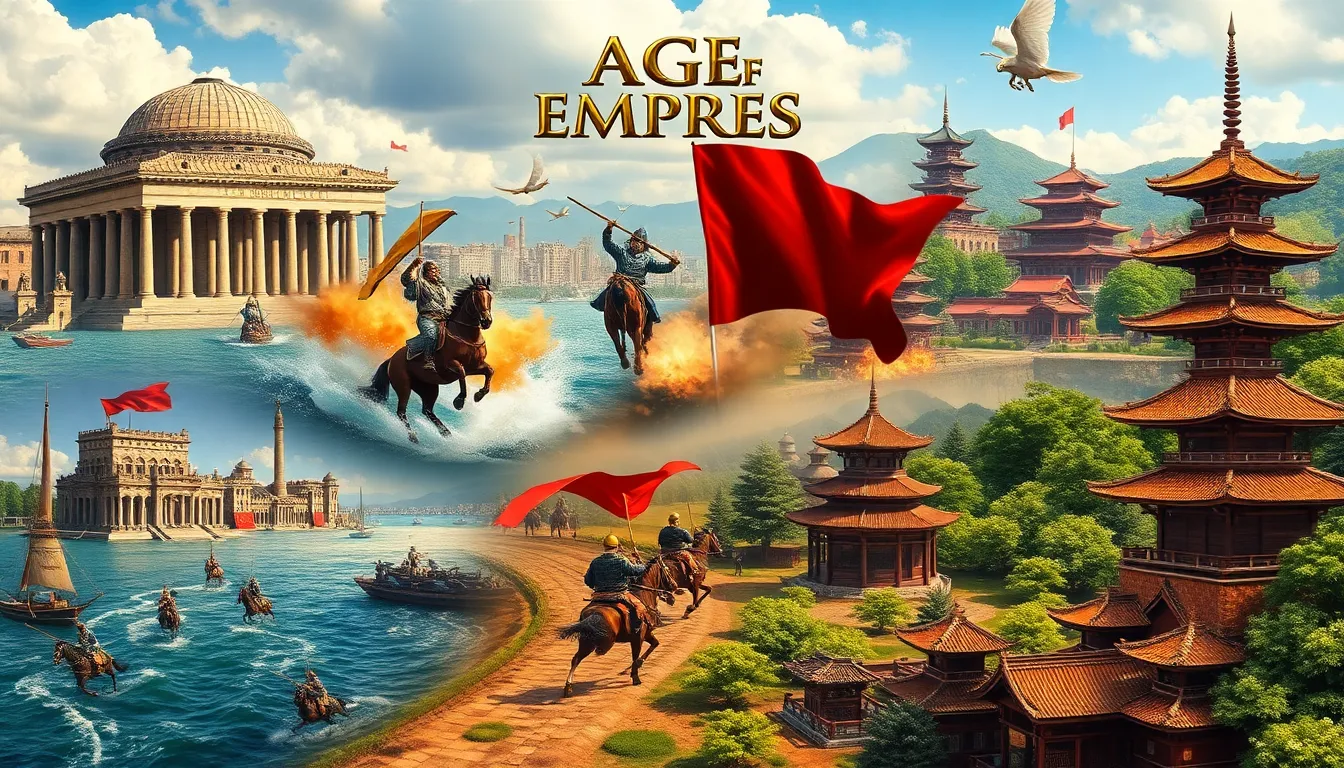In the world of real-time strategy games, few titles stand out like Age of Empires. This iconic series immerses players in the rich tapestry of history, allowing them to build and expand their own civilizations. Each civilization offers unique strengths, strategies, and cultural flavors, making every game a fresh experience.
From the mighty Romans to the resourceful Japanese, the diversity of civilizations in Age of Empires not only shapes gameplay but also provides a fascinating glimpse into historical societies. Players must navigate the complexities of economy, warfare, and diplomacy, all while leveraging their civilization’s unique traits. Understanding these civilizations is key to mastering the game and achieving victory on the battlefield.
Table of Contents
ToggleOverview of Age of Empires Civilizations
Age of Empires features a diverse array of civilizations, each embodying unique strengths, weaknesses, and abilities. Players choose from various societies, with historical accuracy woven into their characteristics.
Key Civilizations
- Romans: Known for their strong economy and architectural advancements, Romans start with extra resources.
- Japanese: Exceptional at infantry combat, the Japanese boast powerful soldiers with increased attack power.
- Mongols: Renowned for their fast cavalry units, Mongols excel in mobility and hit-and-run tactics.
- Greeks: With a focus on naval warfare, the Greeks leverage advanced ship technology for dominance at sea.
Civilization Traits
Each civilization possesses unique traits that influence gameplay. Traits include:
- Economic Bonuses: Some civilizations gather resources faster or start with additional resources.
- Military Advantages: Certain nations train specific units faster or benefit from enhanced armor and attack stats.
- Technological Enhancements: Civilizations may have exclusive technologies or upgrades, impacting strategy.
Civilization Diversity
Civilizations range across various historical periods and regions, offering unique strategic advantages. Players encounter over 30 distinct civilizations, from ancient empires to early modern societies. This diversity encourages diverse gameplay styles and requires players to adapt their strategies based on the civilization they choose.
Gameplay Mechanics
Players utilize each civilization’s strengths to manage economy, warfare, and diplomacy effectively. Unique traits influence how players approach resource management, troop deployment, and territorial expansion. Mastering these elements proves essential for securing victory in the game.
Major Civilizations in Age of Empires

Age of Empires features a broad array of civilizations, each contributing unique strategies and gameplay styles. The distinctions among these societies enhance the player’s experience through varied strengths and play mechanics.
Western Civilizations
Western civilizations in Age of Empires include the Romans, Greeks, and Franks, among others. Each civilization showcases specific traits:
- Romans: Known for a strong economy, they benefit from faster construction of buildings and improved military technologies.
- Greeks: Excel in naval warfare, offering advantages in maritime battles with superior ships and advanced technologies.
- Franks: Feature powerful cavalry units, which thrive in battles due to increased hit points and faster movement speed.
These civilizations often emphasize a balanced approach between economic management and military prowess, encouraging players to develop versatile strategies.
Eastern Civilizations
Eastern civilizations comprise groups like the Japanese, Mongols, and Chinese. They each provide unique gameplay experiences:
- Japanese: Exceptional in infantry combat, they possess stronger samurai units and benefits in resource gathering efficiency.
- Mongols: Renowned for their fast cavalry, they excel in hit-and-run tactics, allowing for rapid territorial control.
- Chinese: Offer diverse strengths in both economy and military with unique technologies that support a strong population and robust defenses.
The Eastern civilizations encourage aggressive strategies and tactical innovations that impact both offensive and defensive gameplay.
Unique Features of Each Civilization
Each civilization in Age of Empires offers unique attributes that influence gameplay. These features include distinct economic mechanics and military capabilities.
Economy and Resource Management
- Romans: Benefit from faster building construction and an efficient economy due to their access to improved resource gathering technologies.
- Chinese: Start with additional villagers but less food, encouraging strategic resource management and careful expansion of their economy.
- Mongols: Gain a significant economic advantage through their nomadic style, which allows for effective resource gathering from multiple locations without settling down.
- Japanese: Excel in gathering resources with unique bonuses for farming, allowing for a strong food economy early in the game.
- Greeks: Feature an economy that thrives on naval control, enhancing their trade and resources on water maps.
Military Strengths and Weaknesses
- Franks: Possess powerful cavalry units, enabling swift and effective military campaigns, though their infantry lacks diversity.
- Japanese: Exhibit strong infantry combat prowess, featuring samurai units that excel in defense and offense, offset by slower technological advancements.
- Mongols: Renowned for their fast cavalry, they specialize in hit-and-run tactics; however, their infantry is comparatively weaker in prolonged engagements.
- Greeks: Dominant in naval warfare with superior ships, they struggle against aggressive land armies that can outmaneuver them.
- Chinese: Have a balanced military with a mix of strong archers and infantry; their reliance on technology can be a weakness if they fall behind in upgrades.
Strategies for Playing Different Civilizations
Players can enhance their gameplay in Age of Empires by adapting strategies specific to each civilization’s strengths and traits. This approach requires careful planning and resource management at various stages of the game.
Early Game Tactics
- Prioritize Economy: Focus on efficient resource gathering early in the game. Use civilizations like the Romans and Chinese to accelerate building construction and villager production. Capitalize on their economic bonuses to establish a solid foundation.
- Scout Effectively: Utilize the Mongols’ speed to quickly explore and identify resource locations. Identify key areas for expansion and potential threats from opponents’ bases. Early scouting may uncover strategic advantages.
- Expand Territory: Secure additional resources by establishing town centers near fertile lands or gold mines. Early territorial expansion for civilizations, like the Japanese, boosts resource input, enabling robust unit production.
- Build Military Presence: Construct military buildings early on to prepare for potential aggression. The Franks allow fast cavalry production, which can serve as advantageous early-game raiders, disrupting enemy economies.
- Utilize Unique Units: Take advantage of unique units available to each civilization. Japanese players benefit from strong infantry, whereas Greeks can start naval combat early to control water resources.
Late Game Strategies
- Focus on Technology: Invest in technology upgrades as the game progresses. Civilizations like the Chinese thrive on technological advancements, granting superior military options and economic boosts.
- Diversify Army Composition: Create a balanced army that complements the unique strengths of the chosen civilization. The Mongols excel in mobile cavalry tactics, while the Japanese can leverage powerful infantry support in larger engagements.
- Control Key Resources: Maintain control of critical resources and trade routes. Naval civilizations, such as the Greeks, can dominate waterways, providing strategic territorial advantages and resources for advanced units.
- Employ Diplomacy: Use diplomatic ties to create alliances or weaken opponents. Building relationships can prevent early confrontations, allowing civilizations to strengthen their economy and military forces.
- Execute Strategic Offense: Launch assaults using combined arms tactics. Civilizations with unique advantages, such as the Romans with their heavy infantry, can capitalize on technological peak strengths to dominate opponents decisively.
By tailoring strategies to the specific qualities and traits of each civilization, players can master Age of Empires and increase their chances of achieving victory through effective resource management, tactical military engagement, and strategic territorial expansion.
The diverse civilizations in Age of Empires offer players a rich tapestry of historical strategies and gameplay styles. Each civilization’s unique traits encourage players to explore various approaches to economy and warfare. By understanding the strengths and weaknesses of their chosen society, players can develop effective tactics that enhance their chances of success.
As players navigate through the complexities of resource management and military engagement, the game’s immersive experience continues to captivate. The blend of history and strategy in Age of Empires not only entertains but also educates, making each session a rewarding journey through time. Embracing the unique characteristics of each civilization allows players to truly master the art of empire building.




